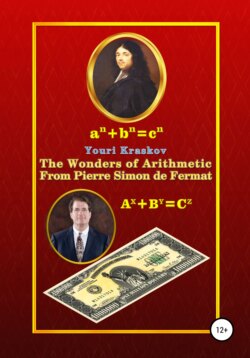Читать книгу The Wonders of Arithmetic from Pierre Simon de Fermat - Youri Veniaminovich Kraskov - Страница 9
3. What is a Number?
3.4. The Descent Method
3.4.1. A Little Bit of " Sharpness of Mind" for a Very Difficult Task
ОглавлениеWe will now consider another example of the problem from Fermat's letter-testament, which is formulated there as follows:
There is only one integer square, which increased by two, gives a cube, this square is 25.
When at the suggestion of Fermat, the best English mathematician of the time John Wallis tried to solve it, he was very vexed and forced to acknowledge he could not do it. For more than two centuries it was believed that Leonard Euler received the solution to this problem, but his proof is based on the use of "complex numbers", while we know these are not numbers at all because they do not obey the Basic theorem of arithmetic. And only at the end of the twentieth century André Weil using the Fermat's triangles method still managed to get a proof [17].
It was a big progress because a purely arithmetic method was used here, however, as applied to this problem, it was clearly dragged the ears. Could Fermat solve this problem easier? We will also extract the answer to this question from the cache, what will allow us to reveal this secret of science in the form of the following reconstruction. So, we have the equation p3=q2+2 with the obvious solution p=3, q=5. To prove Fermat's assertion, we suppose that there is another solution P>p=3, Q>q=5, which satisfies the equation
P3=Q2+2 (1)
Since it is obvious that Q>P then let Q=P+δ (2)
Substituting (2) in (1) we obtain: P2(P–1)–2δP–δ2=2 (3)
Here we need just a little bit of “sharpness of mind” to notice that δ>P otherwise equation (3) is impossible. Indeed, if we make a try δ=P then on the left (3) there will be P2(P–4)>2 what is not suitable, therefore there must exist a number δ1=δ–P. Then substituting δ=P+δ1 in (3) we obtain
P2(P–4)–4δ1P–δ12=2 (4)
Now we will certainly notice that δ1>P otherwise, by the same logic as above, on the left (4) we get P2(P–9)>2 what again does not suitable, then there must exist a number δ2=δ1–P and after substituting δ1=P+δ2 in (4), we obtain P2(P–9)–6δ2P–δ22=2 (5)
Here one can no longer doubt that this will continue without end. Indeed, by trying δi=P each time we get P2(P−Ki)>2. Whatever the number of Ki this equation is impossible because if Ki<P and P>3 then P2(P−Ki)>2 and if Ki≥P then this option is excluded because then P2(P−Ki)≤0
To continue so infinitely is clearly pointless, therefore our initial assumption of the existence of another solutions P>3, Q>5 is false and this Fermat's theorem is proven.
In the book of Singh, which we often mention, this task is given as an example of the “puzzles” that Fermat was “inventing”. But now it turns out that the universal descent method and a simple technique with trying, make this task one of the very effective examples for learning at school.
Along with this proof, students can easily prove yet another theorem from Fermat’s letter-testament, which could be solved only by such a world-famous scientist as Leonard Euler:
There are only two squares that increased by 4, give cubes, these squares will be 4 and 121.
In other words, the equation p3=q2+4 has only two integer solutions.
